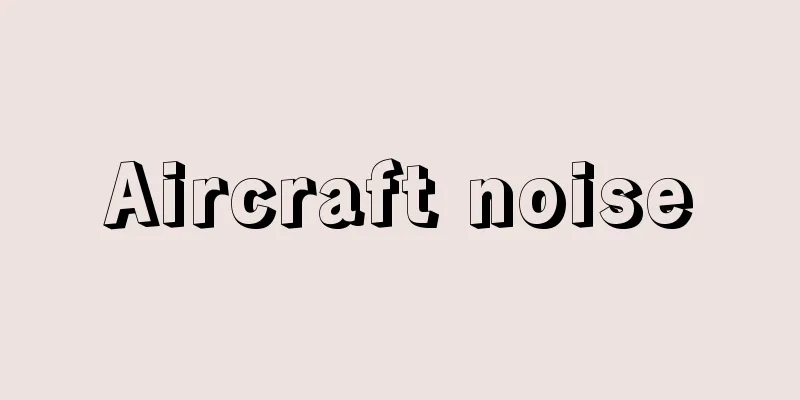Aircraft noise

|
Noise caused by aircraft taking off and landing. In Japan, aircraft noise became a major social issue in 1959 (Showa 34), when large jet planes began operating on international and domestic routes. Residents living near airports and military bases complained about health, lifestyle, and emotional damage caused by noise and exhaust fumes during takeoff and landing, and the issue even escalated into lawsuits. As a response from the government side, the Aircraft Noise Prevention Law was enacted in 1967 (Law Concerning the Prevention of Disturbances Caused by Aircraft Noise in the Vicinity of Public Airports, Law No. 110 of 1967), which designated 14 of the airports established and managed by the government as designated airports, and subsidies for soundproofing work and relocation costs for schools, hospitals and private homes are provided. Furthermore, Osaka International Airport and Fukuoka Airport, which have particularly serious noise problems, were designated as surrounding development airports, and the Airport Surrounding Area Development Organization, an authorized corporation (later an independent administrative corporation), was established to carry out projects commissioned by the government and surrounding area development projects. Additionally, noise control projects are being carried out at Narita International Airport in accordance with the Special Measures Law for Countermeasures against Aircraft Noise in the Vicinity of Designated Airports. As an administrative policy target for noise standards, the "Environmental Standards for Aircraft Noise" were established in 1973 under the Basic Law for Environmental Pollution Control. In residential areas, the WECPNL (Weighted Equivalent Average Perceived Noise Standard, a unit of assessment for "noisiness") is set at 70 or less, and in other residential areas at 75 or less. [Akira Akiba] countermeasureAircraft noise is mainly caused by exhaust gases expelled at high speed from jet engines that disturb the atmosphere, and the most effective countermeasure is to reduce the noise at the source. The amendment of the Aviation Law in October 1975 made it impossible to fly aircraft that exceeded the set noise standards. Noise reduction measures are being implemented for each model, but the development of turbofan engines with high bypass ratios in particular has contributed greatly to improving operational efficiency and reducing noise. Furthermore, long-distance ocean flights previously required aircraft with three or more engines, but now twin-engine aircraft are also permitted as long as safety standards are met. As a result, even on long-distance routes, the main aircraft is shifting from four-engine jumbo jets and three-engine McDonnell Douglas MD-11s to the Boeing 777, a large aircraft with two large engines, and noise levels have been greatly improved. Furthermore, the Boeing 787, a medium-sized aircraft that is quieter due to its reduced aircraft weight, has appeared, and measures to reduce noise sources have progressed compared to the past. At each airport, noise reduction measures are being implemented, such as restricting nighttime and early morning flights, flight routes that avoid residential areas, adjusting engine thrust, etc. The most effective countermeasure is to separate the airport from residential areas, and the construction of Kansai International Airport and Chubu Centrair International Airport on artificial islands and the expansion and relocation of Tokyo International Airport offshore also serve as noise reduction measures. On the other hand, airports have been able to coexist with the local community by changing the functions of the areas around the airport to make them less susceptible to the effects of noise. [Akira Akiba] [Reference items] | | | | |Source: Shogakukan Encyclopedia Nipponica About Encyclopedia Nipponica Information | Legend |
|
航空機の発着に伴う騒音。日本において航空機騒音が大きく社会問題化したのは、1959年(昭和34)国際線、国内幹線に大型ジェット機が就航するようになってからである。空港・軍事基地周辺の住民から離着陸時の騒音や排気ガスによる健康被害、生活被害、情緒被害が指摘され、訴訟問題にも発展していった。 行政側の対応としては、1967年に航空機騒音防止法(「公共用飛行場周辺における航空機騒音による障害の防止等に関する法律」昭和42年法律第110号)を制定し、国の設置・管理する空港のうち14の空港を特定飛行場として、学校、病院や一般住宅の防音工事助成や移転費用の補助を実施している。さらに、とりわけ騒音問題が深刻である大阪国際空港、福岡空港を周辺整備空港に指定し、認可法人(のち独立行政法人)空港周辺整備機構を設置、国からの受託事業や周辺開発事業を進めている。また、成田国際空港においても、特定空港周辺航空機騒音対策特別措置法により騒音対策事業を実施している。 騒音基準の行政上の施策目標値としては1973年に公害対策基本法に基づいて「航空機騒音に係る環境基準」が設定された。住居専用地域ではWECPNL(加重等価平均感覚騒音基準。「やかましさ」の評価単位)が70以下、その他の住居地域では75以下と定められている。 [秋葉 明] 対策航空機騒音は、主としてジェットエンジンから高速で噴出される排気ガスが大気を攪乱(かくらん)するために生ずるものであり、もっとも有効な対策としては発生源の騒音を低くすることである。1975年10月の航空法の改正により、定められた騒音の基準値を超えた航空機の飛行ができなくなった。それぞれの機種に応じて減音対策を実施しているが、とりわけ、高バイパス比のターボファンエンジンの開発は運航効率の向上、低騒音化に大きく貢献している。さらに、かつては長距離洋上飛行は3基以上のエンジンを有するものでなくてはならなかったが、安全性を満たせば双発機でも認められるようになった。その結果長距離路線でも、4基のエンジンを有するジャンボ機や3基エンジンのマクダネル・ダグラスMD-11型機などから、大型機でありながら大型エンジン2基のボーイング777型機へと主力が変わりつつあり、騒音の面でも大きく改善されている。さらに、機体重量の低減化などで低騒音となった中型機のボーイング787型機が登場し、かつてと比べると、騒音発生源の面からの対策が進んだ。 それぞれの空港においては、夜間や早朝の運航の規制を実施するほか、運航にあたっては居住地域を避ける飛行ルートや、エンジン推力を調整するなど、運航方式による騒音軽減対策が実施されている。もっとも有効な対応策は空港と居住地域の分離であり、関西国際空港や中部国際空港の人工島による設置や東京国際空港の沖合いへの拡張移転は騒音対策をも兼ねている。 また、一方では、空港周辺を騒音の影響をあまり受けない機能に改めることによって、空港と地域との共存がなされてきた。 [秋葉 明] [参照項目] | | | | |出典 小学館 日本大百科全書(ニッポニカ)日本大百科全書(ニッポニカ)について 情報 | 凡例 |
>>: Aeronautical (aviation) meteorology
Recommend
Harajuku
It refers to the area around Harajuku Station on ...
Law of local elections - Law of local elections
This refers to the system of appointment of offici...
Solonchak
...When alkali-soluble black humic acid accumulat...
Kashisho - Kashisho
…On the other hand, the “hu fu” (bed) seen in Han...
Pistoia (English spelling)
The capital of the province of Pistoia in Tuscany,...
Taglioni, Maria
Born: April 23, 1804 in Stockholm [Died] April 24,...
Tukulti-ninurta I (English spelling)
…In fact, even after the death of the king, excel...
Ambassador - Ambassador
He is a god worshipped mainly in fishing villages...
MF - M.F.
Abbreviation for medium frequency. One of the cla...
Emperor Yuan
276‐322 First emperor of the Eastern Jin dynasty i...
Dog nails - Inukugi
A nail that secures rails to sleepers, prevents ra...
Mosen (Felt) - Mosen
Same as felt. "氈" means a carpet, and or...
Principal axis transformation
Given the quadratic formula f ( x , y ) = ax2 + 2...
Maratta (English spelling) Carlo Maratta
1625‐1713 Italian painter. Also known as C. Maratt...
Ares - Ares (English spelling)
In Greek mythology, Ares is the god of war and mu...









